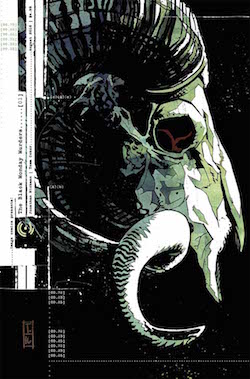Thursday Comics Hangover: Money is power
Midway through the first issue of The Black Monday Murders, a master of finance lectures a class full of eager young geniuses who are about to enter the stock market. He asks them, “you want real advice? Here it is. The first million dollars you make is self-financed. You earn it with your blood. The cost is your health, your family, your friends. You pay, understand?” It’s not quite as splashy as Gordon Gekko’s “greed is good” monologue from Wall Street, but it’s a speech that resonates with the same kind of honesty.

Written by Jonathan Hickman and illustrated by Tomm Coker, Monday is high on its own high concept: what if the top one percent of the top one percent — the wealthiest American families — understood that economics is a black magic? What if a secret society of literal financial wizards were in charge of controlling the entire world’s wealth? What if the power money holds proved to be more than just psychological?
Monday is an impressive package of a book: at five dollars, it’s packed with lots of story pages and also pages full of text and Hickman’s signature graphic design flourishes — some character dossiers, a family tree, an intriguing twist on Snopes.com, a few typographic larks. It’s a deep, immersive dive into a world that Hickman has undoubtedly outlined down to the finest detail. (Hickman has proven to be a meticulous planner; almost all of his Marvel Comics work—hundreds of comics, issued monthly over the course of years—can be read as one single story with a beginning, middle, and end.) We learn about the Caina Investment Bank, the shadowy cabal formed in the wake of the stock market collapse of 1929, and we meet Detective Theo Dumas, an unconventional police officer who is called in to investigate a bizarre murder scene in New York’s financial district.
Coker’s art is exactly right for a book like this: it’s reminiscent of the photorealism of Alex Maleev without the smoky obfuscation. Coker is a stickler for detail: the corkboard in Dumas’s office is laid out with all kinds of tantalizing hints and details that will no doubt play out in issues ahead. The elaborate murder scene in the climax of the book is portrayed unflinchingly without feeling exploitative, and the facial expressions, if a bit stolid, are clear and easy to understand. Colorist Michael Garland gives each scene its own palette, from the slightly sick fluorescent lights of a classroom to the warm, burnished wood of a multi-billionaire’s apartment.
It’s easy to be swept up in the promise of a first issue, before the story plays out and the possibilities start closing up, one after another. But Monday left me feeling hopeful for the future of the story in a way that most first issues do not: the confidence and the depth on display in this issue make it one of the most promising debuts I've read this year.
By attacking the idea of economics as a dark art with its own set of rules, Hickman opens up a world of metaphors that, to my knowledge, has never fully been explored before in comics. He could make high-level economic concepts understandable to a general audience through artful allegory familiar to almost every reader of American comic books. If any writer can successfully translate the dynamics of modern economics to popular culture via a mystery/fantasy mashup, it’s Hickman.